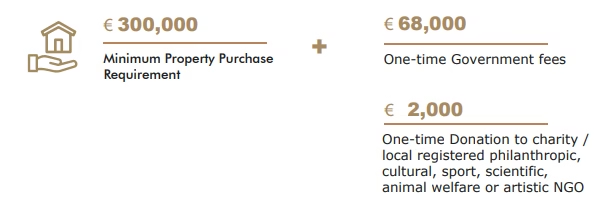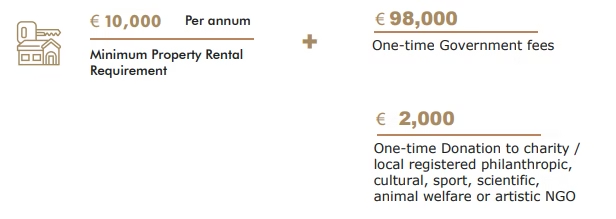Residency by Investment Program
Malta
Long Term Residency in Malta (EU)
Minimum Investment
€375,000 (Real Estate)
Processing Time
6-9 Months
Visa Free Travel
within schengen
area
Long Term Residency in Malta (EU)
Malta continues to be one of Europe’s most attractive destinations for individuals seeking stability, Mediterranean living, and access to the European Union. The Long Term Residency in Malta pathway offers non-EU nationals the right to live, work, and study in Malta with many of the same benefits enjoyed by citizens.
While often used interchangeably, Malta permanent residency and long-term residency have subtle differences. Permanent residency programs, such as the Malta Permanent Residence Programme (MPRP), typically involve a direct investment in Maltese property or government bonds. Long-term residency, on the other hand, is primarily based on years of legal residence and integration rather than upfront investment. Both routes, however, eventually allow applicants to enjoy similar rights and benefits.
Understanding the Malta Long Term Residency Permit
The Malta long term residency permit allows non-EU nationals who have resided in the country for a continuous period (generally five years) to gain more secure residency rights. Unlike short-term visas, this permit provides greater flexibility, including:
The ability to change employers without reapplying for a work visa
Access to Malta’s high-quality healthcare and education systems
Freedom to travel visa-free within the Schengen Zone

Where is Malta?

Benefits of Long Term Residency in Malta
- Permanent residency in 6-9 months
- Family members Included
- No minimum presence required
- No Worldwide Tax: Remittance basis only
- Certificate of Permanent Residency for life
- Malta Residence card - (renewable every 5 years) visa free travel within Schengen area
Key Malta Residency Requirements
Option 1
Real Estate Acquisition

Option 2
Rental Agreement

Eligibility Requirements

No Criminal Record

Good Health
Show a minimum network of €650,000
Home purchase or property rental

One-time Gov't Fee

Donation to local approved charity

Malta Residency Card
Application Steps And Timeline
Residency Application
• Collect supporting documents & file application for Residency

Processing Time
• Application reviewed for source of funds, background / Due Diligence checks initiated

Compliance Time
• In Principle approval of application

• Purchase or rent a property

• One time Government fee and Donation to local approved charity

• Purchase Health insurance

• Issuance of Residency Cards

Why Work With Us?

Decade of
Experience

Government
Authorised Agent

Tailor Made
Solutions

Success
Rate

Strict
Confidentiality
Long Term Residency Malta 2025
Frequently Asked Questions
1. What is the Long Term Residency Malta 2025 program?
It is a legal framework allowing non-EU nationals to live and work in Malta indefinitely after meeting specific Malta residency requirements 2025.
2. How do I obtain the Certificate of Residency Malta?
After fulfilling residency criteria, you apply through the Identity Malta Agency, providing proof of residence, income, health insurance, and biometric data.
3. What is the difference between a Malta long term residency permit and Malta permanent residency?
The long-term permit is earned through continuous legal stay, while Malta permanent residency (MPRP) is investment-based. Both grant similar rights once approved.
4. How long must I live in Malta before applying for long-term residency?
Generally, a continuous stay of five years is required, though specific cases may vary
5. Do I need to invest in property to qualify?
No. Unlike the permanent residency investment route, the Malta long term residency permit is based on residence duration, employment, and integration.
6. Can family members be included in my application?
Yes. Spouses and dependent children can usually be included if you meet financial and accommodation requirements.
7. Is Maltese citizenship automatic after long-term residency?
No. Citizenship requires a separate application and usually a minimum of ten years of legal residence plus additional criteria.
Other Citizenship Options
-
St.Kitts & Nevis Citizenship Program
St. Kitts & Nevis is located in the northern section of the eastern Caribbean Sea approximately 2,000 km2 southeast of Miami (USA). Independence was gained from Britain in 1983 and a twin island federation was formed; Nevis with an area of 93.2 km2 and St. Kitts with 168.4 km2.
-
antigua and barbuda passport by investment
Antigua also known as Waladli or Wadadli by the native population is an island in the West Indies. It is the Leeward Islands in the Caribbean region and the main island of the country of Antigua and Barbuda. In November 1981, Antigua & Barbuda became an independent nation within the Commonwealth Nations.
-
Grenada Citizenship and Passport by Investment
Grenada is also known as the ‘Isle of Spice’ and is one of the most magnificent islands in the West Indies. The nation of Grenada measures 344 km2. It is composed of three main islands: Grenada, Carriacou and Petite Martinique. The proximity of Grenada to the equator ensures a tropical climate with average temperatures of 23°C and 28 °C.
-
Malta Citizenship by Investment
Malta is a neutral, safe and stable country with friendly people living a European lifestyle but with a Mediterranean quality of life. It is a densely populated country where the majority of the population lives in the north side of the country. The Republic of Malta is the place if you want to enjoy the Mediterranean quality of life whilst living a European lifestyle
-
Saint Lucia Citizenship By Investment Program
Known as the ‘Helen of West Indies’, St Lucia is located in the East of the Caribbean Sea and it is considered to be one of the most politically and economically stable countries in the region – which factors have served to attract foreign business and investment. The economic lifeline of Saint Lucia is the tourism industry, followed by crop export and manufacturing.
-
Vanuatu Citizenship Program
Vanuatu, officially known as the Republic of Vanuatu, is an archipelago nation, spread across 82 islands in the south Pacific Ocean. The country’s capital and largest city are Port Villa and its official languages are Bislama, French and English – though over 100 languages are estimated to be spoken locally. The local currency is the Vanuatu VATU.
 ENGLISH
ENGLISH  Arabic
Arabic Persian
Persian 





